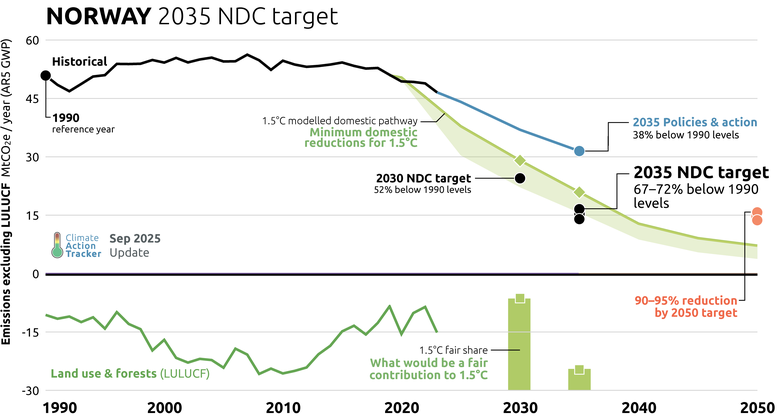2035 NDC
2035 NDC Target Overview
In its 2035 NDC, Norway has committed to reducing emissions by 70-75% below 1990 levels by 2035. While Norway’s new NDC is one of the few that we consider 1.5°C compatible compared to modelled domestic pathways, its submission contains several key issues which raise serious concerns about the true ambition of Norway’s 2035 target and its commitment to reducing domestic emissions.
While the target is based on the emissions level in 1990 excluding the land use and forestry sector (LULUCF), Norway plans to count the sector's carbon sink towards achieving its 2035 target. Known as a “gross-net” approach, the CAT is critical of such accounting methods because relying on land sinks reduces the pressure on governments to curb fossil fuel emissions. Norway has also not been transparent on the scope of the land sink in its NDC, providing neither the land sector’s estimated contribution in 2035, nor the methodology to determine its contribution.
Norway plans, in cooperation with the EU, to rely on international carbon markets and to purchase carbon credits as allowed under the Paris Agreement's Article 6 mechanisms – “if deemed necessary” – to achieve its 2035 target. It is unclear what Norway will consider “necessary” to meet its 2035 target, making it difficult to evaluate this part of the NDC.
In our recent briefing on Article 6 mechanisms, the CAT warns that the use of carbon credits may allow countries to delay or avoid truly ambitious domestic climate action, especially in the absence of clear information on the scale and source of credits to be purchased. Norway’s continued refusal to commit to a timeline for phasing out oil and fossil gas production, despite being Europe’s biggest fossil gas supplier and a major fossil fuel exporter, further undermines its commitment to limit warming to 1.5°C.
Norway submitted its 2035 NDC mitigation target on 26 June 2025, setting a 2035 target of reducing greenhouse gas emissions by at least 70–75% below 1990 levels. This target covers all sectors and all gases.
The CAT excludes emissions from LULUCF from this target, resulting in emission levels of 14–17 MtCO2e in 2035 or a 67–72% reduction below 1990 levels. The submitted NDC's emission level is 1.5°C compatible compared to modelled domestic pathways. However, the 2035 target is not 1.5°C compatible compared to Norway’s fair share of climate action. The gap between these two methods of evaluation is significant. While Norway’s new NDC target is 1.5°C compatible against modelled domestic pathways with a projected emissions level below 21 MtCO2e in 2035, to be compatible against its fair share emissions would need to fall below -25 MtCO2e. This negative threshold is a reminder that Norway needs to go beyond domestic mitigation actions and support emissions reductions abroad through climate finance to meet its fair share.
While Norway's 2035 NDC has an ambitious target that, if achieved, would go beyond the emissions reductions expected with current policies by 2035, it has missed an opportunity to increase the ambition of its 2030 target.
| Norway | 2035 NDC | |
|---|---|---|
| 2030 target | ||
|---|---|---|
| Formulation of target in NDC | No update to the 2030 target. For more information, please see the full 2030 NDC assessment under the Targets tab. | |
| Status | Submitted on 25 November 2020 | |
| 2035 NDC target | ||
|---|---|---|
| Formulation of target in NDC | 70–75% below 1990 levels (excl. LULUCF) by 2035 (incl. LULUCF)1 | |
| Absolute emissions level in 2035 excl. LULUCF |
Level of emissions to be achieved in total through both domestic action and use of international market credits (full NDC target)2 14–17 MtCO2e [67–72% below 1990] [70–74% below 2010] |
|
| Status | Submitted on 26 June 2025 | |
[1] Norway’s 2035 NDC uses “gross-net” accounting, meaning that the 1990 emissions level excludes the LULUCF sector, while planing to count emissions reductions from the LULUCF sector towards achieving the 2035 target.
[2] Due to a lack of a separate target for the use of Internationally Transferred Mitigation Outcomes (ITMOs) to achieve the 2035 target, it is unclear what Norway’s anticipated level of domestic ambition will be.
Ambition
For the world to have a significant chance of limiting warming to 1.5˚C, governments must switch to emergency mode and strengthen both their 2030 targets and current policies to include substantial emissions cuts and significantly contribute to closing the 2030 emission gap. Norway’s 2035 NDC did not increase the ambition of its 2030 target.
2030 NDC Target
| 2030 unconditional NDC target | ||
|---|---|---|
|
Is the target 1.5°C compatible compared to modelled domestic pathways? |
|
|
|
Is this a stronger target? |
|
|
2035 NDC Target
| 2035 unconditional NDC target | ||
|---|---|---|
|
Is the target 1.5°C compatible compared to modelled domestic pathways? |
|
|
|
Does the NDC include sectoral targets? |
|
|
|
Does the NDC include a renewable energy capacity target? |
|
|
|
Does the target align with the country’s net-zero pathway? |
|
|
The submitted NDC target of 14–17 MtCO2e in 2035 is 1.5°C compatible compared to modelled domestic pathways because it is below the 1.5°C compatible threshold of 21 MtCO2e excluding LULUCF. Norway should consider going beyond the minimum targets set by MDPs which should be a floor, not a ceiling, of ambition.
While this 2035 target aligns with cost-effective pathways limiting warming to 1.5ºC, Norway’s fair share of climate action must go beyond what it does domestically. Norway should therefore increase the climate finance it provides to developing countries in order to facilitate substantial emission reductions internationally, and ultimately communicate this as part of its NDC. For more information on Norway’s current climate finance rating of “Insufficient,” read our analysis in the Targets tab.
Norway’s 2035 NDC sets no target to phase out or significantly reduce the production of oil and fossil gas. Although Norway describes its 2035 target as a “fair and ambitious contribution” to global action against climate change, a developed country like Norway with a decarbonised power sector cannot be considered “ambitious” while continuing to extract, produce, export, and profit off oil and fossil gas.
Norway’s NDC does not outline an emissions pathway, policies, nor measures to achieve this target; it notes that more detailed information will be published in its next Biennial Transparency Report (BTR). While Norway’s power sector is decarbonised, sectors like industry and transport still contribute significantly to domestic emissions and will require deep, sustained effort to transition. Under current policies, Norway is not on track to meet either its 2030 or 2035 targets, so it needs to significantly increase its ambition and implementation efforts.
While Norway does not have a net zero target, instead aiming to reduce emissions by 90–95% by 2050, we consider Norway’s 2035 target to be aligned with this goal. The estimated emissions level in 2035 under this new NDC target is nearly the same as our estimate for Norway’s emissions level in 2050, meaning Norway is on track to meet its long term target 15 years early. Further information on Norway’s 2050 target can be found in the Net Zero Targets tab.
| Norway | Target summary (excluding LULUCF) |
|---|
| 2030 target: Emissions reductions below 1990 levels (CAT estimates) | ||
|---|---|---|
| Current policies in 2030 | 27% | |
| 2030 NDC target | 52% | |
| 1.5°C compatible compared to MDPs | 43% | |
| 2035 target: Emissions reductions below 1990 levels (CAT estimates) | ||
|---|---|---|
| Current policies in 2035 | 38% | |
| 2035 NDC target | 67–72% | |
| 1.5°C compatible compared to MDPs | 59% | |
Fairness & Finance
Developed countries need to significantly scale up international climate finance and other means of support. Developed countries should set 1.5°C aligned domestic mitigation targets in their NDCs and communicate the financial and other support they will provide to developing countries. Developing countries should clearly communicate the climate finance they need to set and achieve ambitious 1.5°C aligned conditional targets.
| 2035 unconditional NDC target | ||
|---|---|---|
|
Does the target clearly communicate the climate finance contributions and other support to be provided and mobilised to other countries? |
|
|
Our methodology makes it clear that developed countries should set NDC targets that are at least compatible with their 1.5°C modelled domestic pathways and should meet these targets within their own borders and using their own resources. Norway’s submitted 2035 NDC is 1.5°C compatible compared to modelled domestic pathways, for which it plans to use Article 6 mechanisms “if deemed necessary.”
Developed countries are also expected to complement their domestic mitigation efforts with significant financial support for mitigation in other countries. Norway has communicated that it provides “significant support” to developing countries but does not commit to a specific level of climate financing in its 2035 NDC (Government of Norway, 2025, p. 15).
Norway needs to commit to an ambitious climate finance goal and other forms of support to developing countries for post-2026, as its 2030 and 2035 NDCs do not align with its fair share of global mitigation, and its provision of finance is currently rated as “Insufficient." For more information on Norway’s climate finance rating, see the “Climate finance” section under the Targets tab.
Credibility
Credible NDCs should build on robust national planning processes that translate the economy-wide emissions reduction target into action in all sectors. Governments need to ramp up the implementation of their existing targets and further develop policies to close the – still significant – emissions gap between current policies and 1.5°C pathway. Contradictory policies must be addressed and reversed: fossil fuel production needs to be phased out, while fossil fuel exploration and fossil fuel subsidies need to stop.
| 2035 unconditional NDC target | ||
|---|---|---|
|
Is the target aligned with current policies and driving more ambitious action? |
|
|
|
Does the NDC reference national planning processes for its development? |
|
|
|
Does the NDC reference an institutional framework/plan in place for its implementation? |
|
|
|
Does the target commit to phase out fossil fuel production? |
|
|
|
Does the target commit to stop fossil fuel exploration & subsidies? |
|
|
While Norway’s 2035 NDC target has been approved by the parliament and codified in the Norwegian Climate Change Act, the lack of commitments on phasing out fossil fuel production and exploration undermine its credibility.
While its power sector is dominated by renewable energy and the country is a leader on electric vehicle adoption, Norway continues to expand oil and fossil gas exploration at a time when such actions are wholly incompatible with limiting warming to 1.5°C. In the decade leading up to 2022, the Norwegian government awarded more than 700 oil and gas exploration licenses, more than in the previous 47 years combined (Oil Change International, 2022). These licenses represent 2.8 billion barrels of new oil and gas resources; if these fossil fuels are developed to the full extent, this could lead to an additional 3 GtCO2 of emissions abroad – nearly 60 times more than Norway’s total emissions in 2023.
The energy crisis in Europe prompted by Russia’s war against Ukraine has seen Norwegian exports of oil and fossil gas further increase significantly, taking the country further in the wrong direction and damaging the credibility of its stated climate goals. In January 2025, Norway awarded 53 licenses for oil and gas exploration to 20 companies, with Minister of Energy Terje Aasland arguing that further drilling is necessary to sustain Norway’s fossil fuel output (Buli, 2025).
Meanwhile, production of oil and fossil gas is booming. In 2024, Norwegian exports of natural gas hit record numbers in 6 out of the year’s 12 months, while the Norwegian Offshore Directorate reported in May 2025 that oil production is already higher than the annual forecast (Norsk Petroleum, 2025b; Norwegian Offshore Directorate, 2025). As fossil fuel production increases, investments in oil and gas are also projected to hit a record high of nearly USD 27 bn in 2025 (Jacobsen & Adomaitis, 2025).
These activities undermine global efforts to limit warming to 1.5°C, as countries promised in the Paris Agreement. According to a ruling from the International Court of Justice (ICJ) in July 2025, such behavior may also be illegal. The ICJ ruled that States have a legal obligation to protect the environment and limit greenhouse gas emissions – and breaching this responsibility may incur legal consequences (UN News, 2025). To regain its credibility and satisfy its international obligations, Norway must acknowledge the role its oil and fossil gas exports play in global emissions and move to permanently phase out fossil fuels.
Transparency
Governments should set absolute, economy-wide, emission reduction pathways including all GHG gases, specifying the emissions levels for each year as an absolute level of gross emissions (excluding LULUCF). This level of clarity and transparency will ensure that their reduction targets are immune to creative accounting. NDC targets should primarily focus on their domestic reductions by decarbonising all sectors of the economy rather than relying on forestry sinks, other carbon dioxide removal (CDR) or international carbon markets.
| 2035 unconditional NDC target | ||
|---|---|---|
|
Is the target based on fixed, absolute values? |
|
|
|
Does the target cover all sectors? |
|
|
|
Does the target cover all greenhouse gases? |
|
|
|
Does the target specify an emissions pathway? |
|
|
|
Does the target separate out land use and forestry? |
|
|
|
Does the target separate out other CO2 removal by type? |
|
|
|
Does the target separate out the use of carbon credits? (Article 6) |
|
|
Norway’s 2035 NDC target covers all greenhouse gases and sectors of the economy. However, the NDC leaves the door open for Norway to use carbon credits through Article 6 in cooperation with the EU and reserves the right to go further by buying carbon credits - through Internationally Transferred Mitigation Outcomes (ITMOs) - from outside the European Economic Area (EEA).
The CAT’s latest briefing on Article 6 cautions against using international carbon credits to delay or avoid investing in domestic mitigation, especially when developing high-quality, verifiable carbon credit projects remains extremely difficult. As a wealthy and developed country, Norway should avoid purchasing so-called “low-hanging fruit” credits from poorer countries, saddling them with more difficult and expensive decarbonisation in the future, and instead enhance its domestic ambition.
Norway also plans to use removals from the land and forestry (LULUCF) sector to reach its 2035 target but has not released the methodology it will use to measure these removals. While Norway asserts in its 2035 NDC submission that the final choice of method will not “adversely affect” the level of ambition of its target, without a clear framework for considering emissions and removals from LULUCF, we are forced to rely on estimates in quantifying Norway’s target. Because the carbon sequestration capacity of Norway’s forests has declined over the last few decades and is projected to decline further, having a transparent methodology for evaluating LULUCF is critical for Norway to assess progress towards its 2035 target. The NDC states that Norway will detail this information in future Biennial Transparency Reports, but the exact timing is unknown.
This lack of transparency makes it difficult to assess whether Norway will truly accelerate domestic action and take the steps necessary to achieve full decarbonisation, or continue avoiding its responsibilities as a wealthy, developed nation while profiting off fossil fuel exports. Without a commitment to phase out fossil fuels in a 1.5°C compatible timeframe, Norway risks breaching its obligations under the Paris Agreement and the ICJ’s ruling on state responsibility in the climate crisis. To meet its legal and moral obligations, Norway must act now to mitigate the devastating impacts of climate change.
For more information on Norway’s climate targets and policies, please visit the Summary page. For the CAT’s full recommendations for setting NDC targets that form the basis of the analysis above, please click here.
Assumptions
Norway has committed to reducing emissions by 70–75% below 1990 levels by 2035. Norway calculates its target using a “gross-net” approach, meaning that the 1990 emissions level excludes the LULUCF sector, while its targeted emissions level in 2035 includes emissions from the LULUCF sector.
The CAT excludes LULUCF emissions for its NDC target assessment. To remove the LULUCF emissions in 2035, we estimate the level of removals Norway plans to use in 2035 based on the level of LULUCF it is permitted to count towards the achievement of its 2030 NDC. In agreement with the EU as part of the LULUCF Regulation, Norway is permitted to count -1.6 MtCO2e in removals from its LULUCF sink towards achievement of its NDC target for 2030. This represents 11.6% of Norway’s total LULUCF emissions projected in 2030.
While Norway’s agreement with the EU will likely be updated in the future to set a clear level of removals for the 2035 target, this has not yet happened as of September 2025. For this reason, we assume that LULUCF removals in 2035 will use the same share as in 2030. 11.6% of Norway’s total projected LULUCF emissions in 2035 is -1.3 MtCO2e. Removing this estimated level of LULUCF from Norway’s 2035 target results in an estimated emissions level of between 14 and 16.6 MtCO2e in 2035.
References
Buli, N. (2025). Norway awards oil, gas drilling permits, plans Arctic push. Reuters. https://www.reuters.com/business/energy/norway-awards-53-stakes-latest-offshore-oil-gas-exploration-round-2025-01-14/
Jacobsen, S., & Adomaitis, N. (2025). Norway oil industry set to invest record amount in 2025. Reuters. https://www.reuters.com/business/energy/norway-oil-industry-expects-make-record-high-investments-2025-2025-05-27/
Norsk Petroleum. (2025). Production forecasts. Norsk Petroleum. https://www.norskpetroleum.no/en/production-and-exports/production-forecasts/
Norwegian Offshore Directorate. (2025). Production figures May 2025 [Production figures]. Norwegian Offshore Directorate. https://www.sodir.no/en/whats-new/news/production-figures/2025/production-figures-may-2025/
Oil Change International. (2022). The Aggressive Explorer: How Norway’s Rapid Ramp-up of Oil and Gas Licensing Is Incompatible with Climate Leadership. https://priceofoil.org/2022/02/08/norway-briefing-2022/
UN News. (2025). World Court says countries are legally obligated to curb emissions, protect climate. UN News. https://news.un.org/en/story/2025/07/1165475
Further analysis
Latest publications
Stay informed
Subscribe to our newsletter






